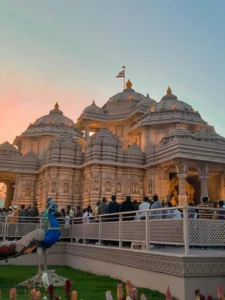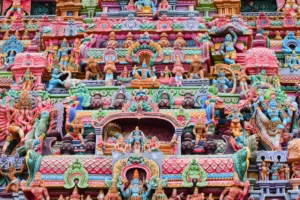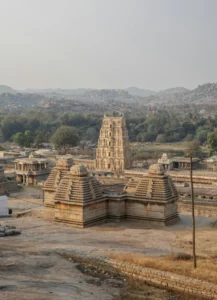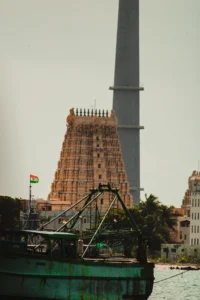Temple architecture was created across Ancient Hindu Temples in India having great quality. Diversities in geography, climate, ethnicity, race, history and language led to different temple construction styles in different regions. Three types of ancient Indian temples can be distinguished. This classification is based on the many architectural styles that were employed in the construction of the temples. Unique Temple Architecture in India can be divided into three main styles:
India’s Three Main Temple Architecture Styles
- The Nagara or the Northern Style
- The Dravida or the Southern Style
- The Vesara or Mixed Style
Furthermore Iconic Temples in India have different architectural styles in places like Bengal, Kerala, and the Himalayan regions.
Table of Contents
ToggleIndia’s Top 10 Most Beautiful Temples in Basics of Architecture
1. Akshardham, Delhi
It was created using the rules of Maharishi Vastu Unique Temple Architecture in India. Italian marble and pink sandstone from Rajasthan were used in its complete construction. The temple is made entirely of stone; neither copper nor iron was used in its construction. The magnificent ten-story mandir is made up of nine domes, 234 elaborately adorned pillars, and more than 20,000 figurines of sadhus and devotees. There are more than 134 life-sized elephants in the shrine. The 11-foot-long murti of Swaminarayan, who is worshipped in the temple, is seated in abhaya mudra beneath the dome. The murtis of Sita Ram, Radha Krishna, Shiv Parvati and Lakshmi Narayan are also housed at the mandir. According to Hindu tradition each murti is composed of panch dhatu or the five metals.

2. Meenakshi Amman Temple, Madurai
Spread across 14 acres the temple, which was constructed in the Dravidian architecture, occupies a sizable portion of Madurai’s downtown. The temple is surrounded by enormous walls that were built in reaction to the invasions. From above, the entire building looks like a mandala. A mandala is a structure that adheres to the ideas of loci and symmetry. Within the temple, other shrines have been constructed. In addition to the two primary shrines, which honor Sundareswarar and Meenakshi, the Famous Indian Temple Structures also features temples honoring Ganesha and Murugan, among other gods and goddesses. The temple also holds goddesses Saraswati, Rukmini, and Lakshmi.Explore more about Meenakshi Amman Temple here.

3. Somnath, Saurashtra
Reportedly built by Gujarat’s talented masons using sandalwood in the Chalukya style, this exquisite temple is situated on the Arabian Sea shore. It has seven floors and is 15 meters high, with a flagpole that is 8.2 meters high on top. The architectural style used in its construction is Chalukya. The Somnath Unique Temple Architecture in India displays the artistry of Gujarat’s best masons, known as the Somapuras. The temple’s layout prevents any land from being visible from the Somnath shoreline to Antarctica.

4. Ramanathaswamy Temple, Rameshwar
Another Famous Indian Temple structure in the Dravidian style, this one has spires that reach the skyline and the longest corridor of them. One of its attractions is a 4,000-foot corridor with almost 4,000 pillars. The temple’s size along with 21 Gopurams (towers) looks astounding. The “Hall of 1000 Pillars” is the primary attraction along with other amazing buildings. It is a fantastic illustration of a proposed theater-style building. Some of the nicest sculptures may be found at “Sesha Mandap” which is located on the opposite side.

5. The Jagannath Temple, Puri
The temple covers more than 400000 square feet. It is surrounded by tall walls. The Ancient Hindu Temple complex has a minimum of 120 shrines. There are elements of Orissan temple architecture in the structure. A magnificent sixteen-faceted monolithic pillar stands in front of the main entrance. The road to the Lord seems to be guarded by two enormous lions at the entryway.
6. The Virupaksha Temple, Hampi
It is covered with murals and sculptures in the Vijayanagara style. The temple features shrines, courtyards, a pillared promenade, a nine-tiered doorway, and numerous other stunning buildings within and outside. The temple was originally built in the first half of the 15th century but Krishnadevaraya renovated it in the 16th century. Several stories from the epics of the Ramayana and Mahabharata are portrayed in the temple’s murals.
7. The Sri Ranganathaswamy Temple, Srirangam
The huge temple complex has a radius of 1,116 meters (10,710 feet) and covers 156 acres (6,31,000 m²). SriRangam Temple is regarded as one of the greatest operational Hindu temples worldwide and one of the largest temple complexes in India. This temple is enclosed by seven concentric walls that total 32,592 feet. It consists of twenty-one Gopurams or towers. The temple’s sheer magnificence appears to be breathtaking.
8. Golden Temple, Amritsar
The Amrit Sarovar lake encircles the 67-square-foot platform that houses Sri Harmandir Sahib, popularly referred to as the Golden Temple. The temple is 40.5 square feet in overall size. There are entrances on all four corners of the shrine. The shrine represents the beliefs of Sikhism. Its entrance is an elaborate archway with intricate inlay work. Gold plating covers the shrine’s façade while passages from the Granth Sahib are engraved into the entryway.
9. Lotus Temple, Delhi
Over 40 meters is the height of the Lotus Temple. The 27 massive white marble petals that emerge from nine ponds and pathways in the shape of a lotus represent the nine joining together spiritual streams of the Bahá’í faith. The main hall, the restrooms, and the ancillary building which includes the reception area, library, and administration building make up the temple. There are bridges, staircases, and walkways with curved balustrades all around the lotus. The nine pools are surrounded by pathways that symbolize the lotus’s floating leaves. The pools were constructed to aid in the building’s ventilation in addition to their aesthetic value.
10. Kailasa Temple, Ellora
It is said that Kailasa Temple is the biggest monolithic structure in the world. The construction of this edifice involved carving a massive mountain and cutting it out from the top. This temple required the removal of more than 400,000 tons of rocks. Starting at the mountain’s summit the carvers worked their way down. Its dimensions are 60 feet (18.29 meters) in height and 200 feet (60.69 meters) in width. Three stories make up the U-shaped temple.


